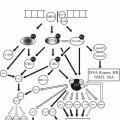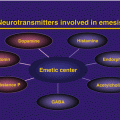© Springer International Publishing Switzerland 2015
Ramon Andrade de Mello, Álvaro Tavares and Giannis Mountzios (eds.)International Manual of Oncology Practice10.1007/978-3-319-21683-6_3030. Bone Sarcomas
Maria Cecília Monteiro Dela Vega1, Pedro Nazareth AguiarJr.1, Hakaru Tadokoro1 and Ramon Andrade de Mello2, 3
(1)
Department of Medical Oncology, Federal University of São Paulo, UNIFESP, Rua Pedro de Toledo, 377, CEP 04039-031 São Paulo, SP, Brazil
(2)
Department Biomedical Sciences and Medicine, University of Algarve, Faro, Portugal
(3)
Department of Medicine, Faculty of Medicine, University of Porto, Porto, Portugal
30.1 Introduction: Epidemiology and Clinical Presentation
Osteosarcomas are primary malignant bone tumor s that are characterized by the production of osteoid or immature bone by malignant cells [1]. They are uncommon, accounting for only 1 % of all cancers diagnosed annually in the United States. There is a bimodal age distribution of the osteosarcoma incidence, which peaks in early adolescence and in adults aged >65 years [2].
A variety of histologic subtypes of conventional osteosarcomas are osteoblastic, fibroblastic, and chondroblastic, accounting for approximately 90 % of all osteosarcomas. Less common variants include Ewing’s sarcoma, small cell, telangiectatic, multifocal, and a malignant fibrous histiocytoma subtype. Surface or juxtacortical osteosarcomas, including parosteal, periosteal, and high-grade surface, differ with respect to the prognosis and therapy.
When diagnosed in adults, osteosarcoma should be differentiated between classical osteosarcoma, which does not have a clearly defined etiology (e.g., the disease in childhood), and secondary osteosarcoma, which is observed almost exclusively in adults (e.g., osteosarcoma related to Paget’s disease and radiation-induced osteosarcoma) [3].
30.2 Diagnosis and Staging Evaluation
Conventional intramedullary osteosarcoma has a predilection for the metaphyseal region of the long bones. A common clinical feature is localized pain that frequently begins post-injury and waxes and wanes over time. The most important finding on physical examination is a soft tissue mass, which is frequently large and tender to palpation [4]. Laboratory evaluation is usually normal, except for elevations in the alkaline phosphatase (in approximately 40 %), lactate dehydrogenase (in approximately 30 %), and erythrocyte sedimentation rate [5, 6].
The staging assessment includes magnetic resonance of the entire length of the affected bone, computed tomography of the chest, bone scan, and/or positron emission tomography (PET) scan. In the absence of symptoms, images of the abdomen are not required because of the extreme rarity of metastasis in this location. It usually spreads hematogenously, and the main site of metastasis is the lung. On presentation, between 10 % and 20 % of patients have demonstrable macrometastatic disease.
30.2.1 Staging
The staging is defined as follows: TX, the primary tumor cannot be assessed; T0, no evidence of a primary tumor; T1, the tumor is ≤8 cm in its greatest dimension; T2, the tumor is >8 cm at its greatest dimension; T3, discontinuous tumors are present in the primary bone site; NX, the regional lymph nodes cannot be assessed; N0, no regional lymph node metastasis; N1, regional lymph node metastasis; MX, the metastases cannot be assessed; M0, no distant metastasis; M1, distant metastasis; M1a, lung metastasis; and M1b, metastasis to other distant sites, including the nodes [7].
The tumors are given a histologic grade (G) as follows: GX, the grade cannot be assessed; G1, well differentiated (low grade); G2, moderately differentiated (low grade); G3, poorly differentiated (high grade); and G4, undifferentiated (high grade) [7].
The stage of the tumor is defined as follows: stage IA: G1–2, T1, N0, and M0; stage IB: G1–2, T2–3, N0, and M0; stage IIA: G3–4, T1, N0, and M0; stage IIB: G3–4, T2, N0, and M0; stage III: G3–4, T3, N0, and M0; stage IVA, any G, any T, N0, or M1a; and stage IVB: any G, T, N0-1, or M1b [7].
30.3 Treatment
The mainstay of treatment is tumor resection surgery, preferably with wide margins. However, it is always necessary to consider limb preservation in patients with localized disease.
After introducing chemotherapy, the survival in patients with localized high-grade osteosarcoma has improved. Chemotherapy comprises two phases: neoadjuvant (evaluation of the in vivo response and eradication of the micrometastases) and adjuvant. Generally, chemotherapy is administered pre- and postoperatively, and the extent of the histological response to preoperative chemotherapy predicts survival. According to the Huvos classification for tumor necrosis osteosarcoma, tumors with improved responsivity to chemotherapy (degrees III and IV) have a better prognosis.
30.4 Intramedullary Nonmetastatic Disease
Initially, postoperative chemotherapy was used, and the 5-year survival rates increased from <20 % to between 40 % and 60 % in the 1970s [8]. Two subsequent randomized studies conducted in the 1980s reported on high-dose methotrexate plus doxorubicin, bleomycin, cyclophosphamide, and dactinomycin and either vincristine or cisplatin. The study demonstrated a significant relapse-free and overall survival benefit for adjuvant chemotherapy that persisted in the long-term [6, 9–11]. However, these trials were limited in size, and the survival benefits were modest.
There is no worldwide consensus on a standard chemotherapy approach for osteosarcoma. The majority of regimens in adjuvant chemotherapy use doxorubicin (75 mg/m2) and cisplatin (100 mg/m2) every 21 days, with or without high-dose methotrexate (8 g/m2), which is followed by rescue leucovorin before each cycle. In adults aged >30 years, the literature emphasizes the use of protocols that do not contain high-dose methotrexate because of the uncertainty of its real value in the cure rate in localized disease (according to pediatric protocols), and there are issues in terms of severe toxicity in adults [12–15].
30.4.1 Metastatic Disease
Patients who present with overtly metastatic osteosarcoma have a poor prognosis, and it is very important to evaluate the possibility of resecting pulmonary metastases.
Regarding the choice of chemotherapy regimen, the same drugs are used for adjuvant treatment, because no randomized studies have explored this topic [14].
30.4.2 Recurrent Disease
Local recurrences should be treated surgically. However, a salvage chemotherapy regimen that administers two courses of ifosfamide (3 g/m2/day) and etoposide (75 mg/m2/day) for 4 days is an option, according to findings from a phase II study, which had a 48 % response rate [16].
Other options include adding carboplatin (400 mg/m2/day on day 0–1), to ifosfamide (1,800 mg/m2/day on day 0–4) and etoposide (100 mg/m2/day on day 0–4), which was associated with a 51 % response rate [17




Stay updated, free articles. Join our Telegram channel

Full access? Get Clinical Tree





